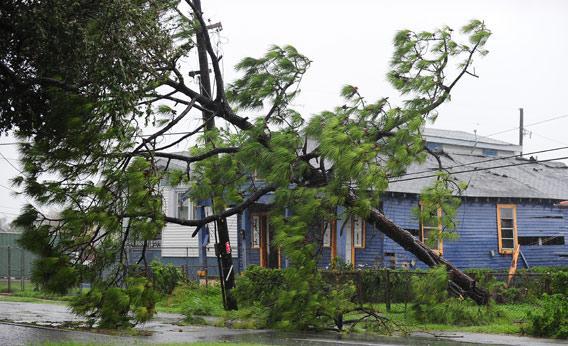Do natural disasters hurt or help the economy? Hurricane Irene, which briefly terrorized the East Coast last summer before fizzling, spurred a series of articles speculating on the potential stimulative impact of a hurricane on a depressed economy. Hurricane Isaac, currently battering the Gulf Coast, doesn’t seem to have had the same impact on economists.
Disaster economics is a subject worthy of more study. For starters, natural disasters really do seem to reduce unemployment. Hurricane Katrina led to a temporary surge in joblessness before reducing the unemployment in the New Orleans metropolitan area well below the national unemployment rate. Of course, it also killed almost 2,000 people and devastated a major American city.
The moral of the story isn’t that we should hope for storms, but that understanding why a disaster can juice unemployment numbers teaches some valuable lessons about the economy as a whole. Most of all it’s a reminder of how America’s current slow, grinding economic recovery could be improved.
The theory of hurricane stimulus is pretty straightforward. A typical recession starts with a brief collapse in private investment spending, often precipitated deliberately by a Federal Reserve interest-rate increase that reduces the profitability of investments. To end the recession, something needs to fill the gap. That could be a surge of public investment, as during a wartime military buildup. In small open economies, a drop in the value of the currency can boost net exports and make investments in domestic production look more attractive. In the United States, an interest rate cut usually serves to break a recession: Cheaper money makes the marginal investment look more profitable, boosting investment spending. But there are other ways of increasing the marginal return to capital. A major technological breakthrough, for example, can spur a surge of investment as everyone rushes to build new fiber-optic cables or telephone lines or factories that build toasters or whatever the state of the art may be.
And a less pleasant way of stimulating investment is to destroy a bunch of existing capital goods. It sounds a bit crazy, but it makes sense. Right now, nobody’s building strip malls. The hangover from the real-estate bubble has everyone scared off, and the rise of digital technology seems to be spurring a structural shift away from big-box retail stores. But despite the sector’s problems, it’s not as if the strip-mall economy has vanished. Every American city continues to be chock full of shopping centers, mostly full of stores, mostly full of people buying things. Overall investment in the sector has declined because the growth outlook looks bad, not because shopping has vanished from the earth. But if a hurricane wrecks half your malls, suddenly that calculus changes and it’s time to build some malls.
Where does the money for this new mall investment come from? Insurance payments, in part. But more from credit. If the marginal return on investment surges—as it would if there were suddenly a need for a bunch of new malls–then lenders will happily lend.
A hurricane isn’t the only way to create this new demand. The reason the American economy is slowly but steadily inching back to full employment is that even absent a huge disaster, stuff is always breaking. Capital goods experience “depreciation.” A leak floods your basement, the UPS delivery truck breaks down, or your office building’s HVAC system needs repair. Given enough time, the return on capital will rise and investment will rebound. The problem with the agonizingly slow recovery is that it’s similar to hurricane stimulus—you’re counting on putting people back to work reducing the country’s stock of useful goods. The more our factories, offices, housing stock, and transportation equipment deteriorate, the more likely we become to build more in the future, but this deals a permanent blow to our prosperity.
The good news is that there are policy tools for boosting the economy that are better than a hurricane.
The federal government could and should be mitigating the downturn by undertaking public investments in the kinds of schools and infrastructure the private sector doesn’t build. We also should target the particular category of investment that’s most depressed—the residential sector. Residential investment is still stuck in a deep slump. One way to help would be for the Federal Housing Finance Agency to stop delaying the Obama administration’s efforts to streamline mortgage refinancing.
The Federal Reserve could do most of all. When a hurricane wrecks a bunch of houses somewhere, that leads to a surge in residential investment because there’s a localized shortage in habitable housing. Because the surge is localized, nobody thinks that the Fed will look at a local spike in rents, see inflation, and raise interest rates to cut off economic activity. But when a prolonged construction slump leads to a slowly growing shortage of rental housing, the picture is less clear. Since March, I’ve been urging the Fed to follow the advice of the president of its Chicago branch and make a clear statement that a bit of inflation is an acceptable price to pay to spark a surge in employment. It’s a dynamic we take for granted in the case of a hurricane. The destruction creates temporary local shortages of whatever’s been wrecked. But rather than responding to the shortage by stifling local demand, we get a surge of activity to rebuild what’s missing and restock depleted inventories.
The financial crisis and the destabilization of expectations it created was effectively nationwide economic hurricane, destroying property and economic value across the country. But neither Congress nor the Federal Reserve nor the federal housing agencies are stepping up to rebuild. If we treated real storms this way, severe natural disasters would lead to permanent depressions. It’s time to start applying lessons of hurricanes to the larger economy.
